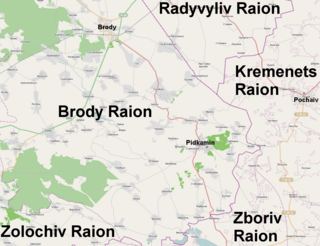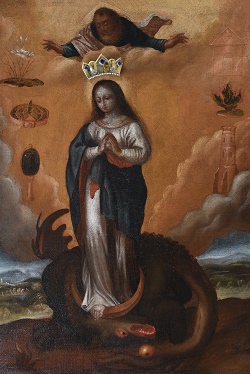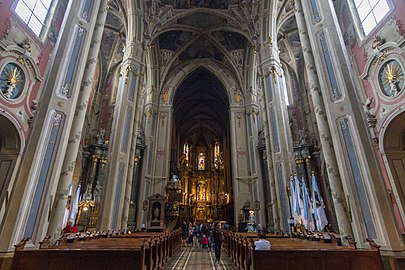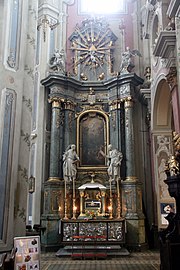
The Black Madonna of Częstochowa, also known as Our Lady of Częstochowa is a venerated icon of the Blessed Virgin Mary housed at the Jasna Góra Monastery in Częstochowa, Poland.

Lubaczów is a town in southeastern Poland, close to the border with Ukraine, with 12,567 inhabitants Situated in the Subcarpathian Voivodeship, it is the capital of Lubaczów County and is located 50 kilometres northeast of Przemyśl.

Marian Franciszek Jaworski was a Cardinal Priest and Archbishop of Lviv of the Latins in the Roman Catholic Church. He was a close friend of Pope John Paul II.

Józef Bilczewski was a Polish Roman Catholic prelate who served as the Archbishop of Lviv from 1900 until his death. He served as a theological and dogmatics professor in the Lviv college after himself having earned two doctorates in the course of his own studies. He earned a reputation as a learned and cultured man; these qualities led to Emperor Franz Joseph I nominating him for the Lviv archdiocese as its head. Pope Leo XIII named him as its archbishop and he set to work prioritizing a range of different pastoral initiatives aimed at revitalizing the faith within people and also prioritizing ecumenical cooperation with other denominations.

The Catholic Church in Ukraine is part of the worldwide Catholic Church, under the spiritual leadership of the Pope in Rome. Catholics make up 10% of the population of Ukraine.

Pidkamin is a rural settlement in Zolochiv Raion, Lviv Oblast, western Ukraine. It is located near the administrative border of three oblasts, Lviv, Rivne, and Ternopil. Pidkamin hosts the administration of Pidkamin settlement hromada, one of the hromadas of Ukraine. Population: 1,895.

The Archdiocese of Lviv is a Latin Church ecclesiastical jurisdiction or archdiocese of the Catholic Church in western Ukraine.

The Dominican Church and Monastery in Lviv, Ukraine is located in the city's Old Town, east of the market square. It was originally built as the Roman Catholic church of Corpus Christi, and today serves as the Greek Catholic church of the Holy Eucharist.

The Diocese of Zamość-Lubaczów is a suffragan Latin diocese of the Catholic Church in the ecclesiastical province of Przemyśl in Poland.

Mieczysław Mokrzycki is Polish-born Catholic prelate, currently serving as the archbishop of Lviv of the Latins in Ukraine.

Jan Henryk de Rosen is best known as a Polish artist of murals and mosaics. He served in World War I in various capacities, rising to the rank of captain in the Polish army and earning a range of military honors. De Rosen also served as a diplomat for Poland. He moved to the United States in 1939 where he continued to complete large-scale commissions for churches and other institutions. In America, De Rosen was a research professor of liturgical art at the Catholic University of America in Washington, D.C.

The Lwów Oath was an oath made on April 1, 1656 by Polish king John II Casimir in the Latin Cathedral of the city of Lwów.

The architecture of Poland includes modern and historical monuments of architectural and historical importance.
The following is a timeline of the history of the city of Lviv, Ukraine.

Archbishop Bolesław Twardowski was a Roman Catholic prelate, who served as an Auxiliary Bishop of the Roman Catholic Archdiocese of Lviv and a Titular Bishop of Telmessos from 14 September 1918 until 3 August 1923 and as the Metropolitan Archbishop of the same Archdiocese from 3 August 1923 until his death on 22 November 1944.

The Most Holy Virgin Mary, Queen of Poland's Church, also known as Sanctuary of Our Lady of Łukawiec is a Roman Catholic church, in the village Łukawiec, in the administrative district of Gmina Wielkie Oczy, within Lubaczów County, Subcarpathian Voivodeship, in south-eastern Poland. It was designed by Henryk Stawicki from Cracow and built between 1980 and 1989.

Our Lady of Łukawiec, earlier Our Lady of Tartaków, also known as Our Lady Full of Graces is a Roman Catholic icon of the Blessed Virgin Mary.

The Most Holy Virgin Mary, Queen of Poland is an honorary title for Mary, mother of Jesus, used by Polish Catholics.

























